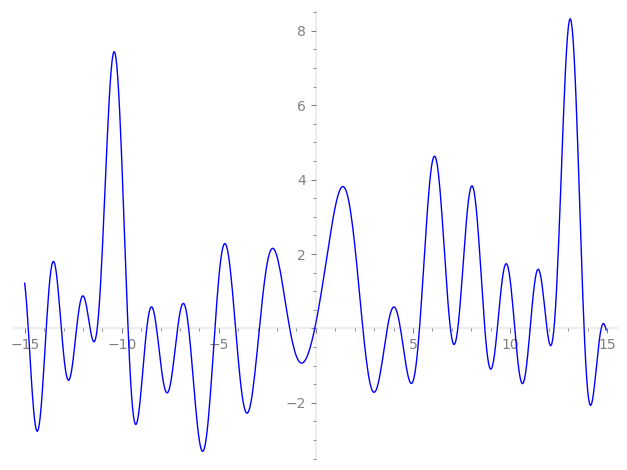| L(s) = 1 | + (0.178 − 2.99i)3-s + (−5.28 − 3.05i)5-s + (−8.93 − 1.07i)9-s + (14.9 − 8.63i)11-s − 19.2·13-s + (−10.0 + 15.2i)15-s + (−17.8 + 10.3i)17-s + (6.09 − 10.5i)19-s + (16.8 + 9.70i)23-s + (6.12 + 10.6i)25-s + (−4.80 + 26.5i)27-s − 3.24i·29-s + (−4.24 − 7.34i)31-s + (−23.1 − 46.3i)33-s + (−33.8 + 58.6i)37-s + ⋯ |
| L(s) = 1 | + (0.0595 − 0.998i)3-s + (−1.05 − 0.610i)5-s + (−0.992 − 0.118i)9-s + (1.35 − 0.784i)11-s − 1.48·13-s + (−0.672 + 1.01i)15-s + (−1.04 + 0.605i)17-s + (0.320 − 0.555i)19-s + (0.730 + 0.421i)23-s + (0.244 + 0.424i)25-s + (−0.177 + 0.984i)27-s − 0.111i·29-s + (−0.136 − 0.237i)31-s + (−0.702 − 1.40i)33-s + (−0.915 + 1.58i)37-s + ⋯ |
\[\begin{aligned}\Lambda(s)=\mathstrut & 588 ^{s/2} \, \Gamma_{\C}(s) \, L(s)\cr =\mathstrut & (-0.381 - 0.924i)\, \overline{\Lambda}(3-s) \end{aligned}\]
\[\begin{aligned}\Lambda(s)=\mathstrut & 588 ^{s/2} \, \Gamma_{\C}(s+1) \, L(s)\cr =\mathstrut & (-0.381 - 0.924i)\, \overline{\Lambda}(1-s) \end{aligned}\]
Particular Values
| \(L(\frac{3}{2})\) |
\(\approx\) |
\(0.1506014082\) |
| \(L(\frac12)\) |
\(\approx\) |
\(0.1506014082\) |
| \(L(2)\) |
|
not available |
| \(L(1)\) |
|
not available |
\(L(s) = \displaystyle \prod_{p} F_p(p^{-s})^{-1} \)
| $p$ | $F_p(T)$ |
|---|
| bad | 2 | \( 1 \) |
| 3 | \( 1 + (-0.178 + 2.99i)T \) |
| 7 | \( 1 \) |
| good | 5 | \( 1 + (5.28 + 3.05i)T + (12.5 + 21.6i)T^{2} \) |
| 11 | \( 1 + (-14.9 + 8.63i)T + (60.5 - 104. i)T^{2} \) |
| 13 | \( 1 + 19.2T + 169T^{2} \) |
| 17 | \( 1 + (17.8 - 10.3i)T + (144.5 - 250. i)T^{2} \) |
| 19 | \( 1 + (-6.09 + 10.5i)T + (-180.5 - 312. i)T^{2} \) |
| 23 | \( 1 + (-16.8 - 9.70i)T + (264.5 + 458. i)T^{2} \) |
| 29 | \( 1 + 3.24iT - 841T^{2} \) |
| 31 | \( 1 + (4.24 + 7.34i)T + (-480.5 + 832. i)T^{2} \) |
| 37 | \( 1 + (33.8 - 58.6i)T + (-684.5 - 1.18e3i)T^{2} \) |
| 41 | \( 1 - 55.6iT - 1.68e3T^{2} \) |
| 43 | \( 1 + 49.7T + 1.84e3T^{2} \) |
| 47 | \( 1 + (-39.6 - 22.8i)T + (1.10e3 + 1.91e3i)T^{2} \) |
| 53 | \( 1 + (-28.9 + 16.7i)T + (1.40e3 - 2.43e3i)T^{2} \) |
| 59 | \( 1 + (-58.8 + 33.9i)T + (1.74e3 - 3.01e3i)T^{2} \) |
| 61 | \( 1 + (-9.10 + 15.7i)T + (-1.86e3 - 3.22e3i)T^{2} \) |
| 67 | \( 1 + (33 + 57.1i)T + (-2.24e3 + 3.88e3i)T^{2} \) |
| 71 | \( 1 - 93.8iT - 5.04e3T^{2} \) |
| 73 | \( 1 + (-3.88 - 6.73i)T + (-2.66e3 + 4.61e3i)T^{2} \) |
| 79 | \( 1 + (52.4 - 90.9i)T + (-3.12e3 - 5.40e3i)T^{2} \) |
| 83 | \( 1 + 51.1iT - 6.88e3T^{2} \) |
| 89 | \( 1 + (130. + 75.1i)T + (3.96e3 + 6.85e3i)T^{2} \) |
| 97 | \( 1 + 188.T + 9.40e3T^{2} \) |
| show more | |
| show less | |
\(L(s) = \displaystyle\prod_p \ \prod_{j=1}^{2} (1 - \alpha_{j,p}\, p^{-s})^{-1}\)
Imaginary part of the first few zeros on the critical line
−9.675262867724118979529058818780, −8.712443187197910458110641490956, −8.207349366860647359493125574496, −7.12347158132747066978894695229, −6.55327611979242978228358192460, −5.20070153791131702776342262117, −4.13546612719090592042484453841, −2.91109975586487444271755259090, −1.34762837458901999377748883782, −0.05861895414064944697151653570,
2.41919003463482768813615567770, 3.67654734529426628448382524851, 4.35338809398759471123664358719, 5.33557266333884942472241341736, 6.92808403838355416514925307727, 7.30804789097626817433819502411, 8.700462091541883600227325310504, 9.344074868963803268109372516715, 10.24423131502762621462947188451, 11.03491959613470074873831330114

